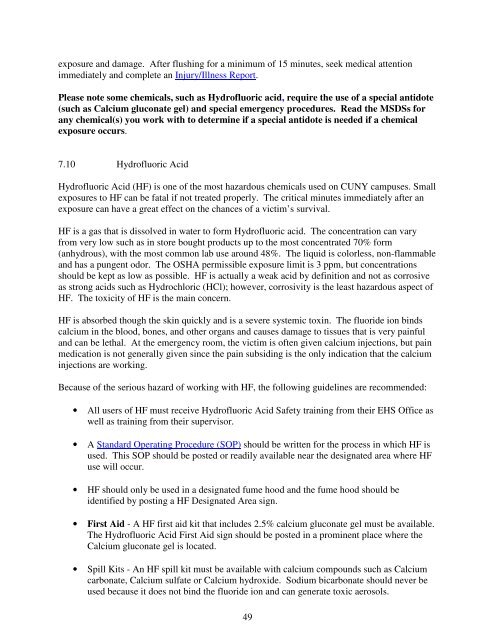Chemical Hygiene Plan - Queensborough Community College ...
Chemical Hygiene Plan - Queensborough Community College ...
Chemical Hygiene Plan - Queensborough Community College ...
Create successful ePaper yourself
Turn your PDF publications into a flip-book with our unique Google optimized e-Paper software.
exposure and damage. After flushing for a minimum of 15 minutes, seek medical attention<br />
immediately and complete an Injury/Illness Report.<br />
Please note some chemicals, such as Hydrofluoric acid, require the use of a special antidote<br />
(such as Calcium gluconate gel) and special emergency procedures. Read the MSDSs for<br />
any chemical(s) you work with to determine if a special antidote is needed if a chemical<br />
exposure occurs.<br />
7.10 Hydrofluoric Acid<br />
Hydrofluoric Acid (HF) is one of the most hazardous chemicals used on CUNY campuses. Small<br />
exposures to HF can be fatal if not treated properly. The critical minutes immediately after an<br />
exposure can have a great effect on the chances of a victim’s survival.<br />
HF is a gas that is dissolved in water to form Hydrofluoric acid. The concentration can vary<br />
from very low such as in store bought products up to the most concentrated 70% form<br />
(anhydrous), with the most common lab use around 48%. The liquid is colorless, non-flammable<br />
and has a pungent odor. The OSHA permissible exposure limit is 3 ppm, but concentrations<br />
should be kept as low as possible. HF is actually a weak acid by definition and not as corrosive<br />
as strong acids such as Hydrochloric (HCl); however, corrosivity is the least hazardous aspect of<br />
HF. The toxicity of HF is the main concern.<br />
HF is absorbed though the skin quickly and is a severe systemic toxin. The fluoride ion binds<br />
calcium in the blood, bones, and other organs and causes damage to tissues that is very painful<br />
and can be lethal. At the emergency room, the victim is often given calcium injections, but pain<br />
medication is not generally given since the pain subsiding is the only indication that the calcium<br />
injections are working.<br />
Because of the serious hazard of working with HF, the following guidelines are recommended:<br />
• All users of HF must receive Hydrofluoric Acid Safety training from their EHS Office as<br />
well as training from their supervisor.<br />
• A Standard Operating Procedure (SOP) should be written for the process in which HF is<br />
used. This SOP should be posted or readily available near the designated area where HF<br />
use will occur.<br />
• HF should only be used in a designated fume hood and the fume hood should be<br />
identified by posting a HF Designated Area sign.<br />
• First Aid - A HF first aid kit that includes 2.5% calcium gluconate gel must be available.<br />
The Hydrofluoric Acid First Aid sign should be posted in a prominent place where the<br />
Calcium gluconate gel is located.<br />
• Spill Kits - An HF spill kit must be available with calcium compounds such as Calcium<br />
carbonate, Calcium sulfate or Calcium hydroxide. Sodium bicarbonate should never be<br />
used because it does not bind the fluoride ion and can generate toxic aerosols.<br />
49
















